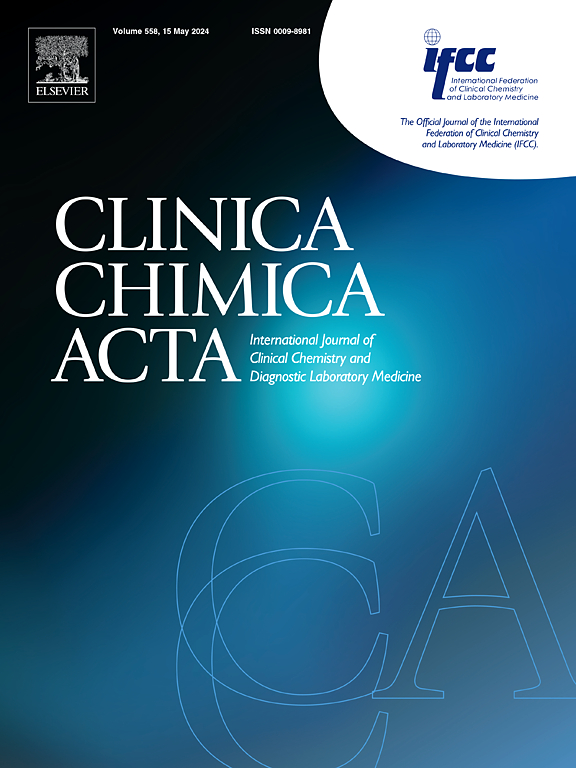Exchangeable serum copper: Adult and pediatric reference intervals and in vitro stability in a nordic cohort
IF 3.2
3区 医学
Q2 MEDICAL LABORATORY TECHNOLOGY
引用次数: 0
Abstract
Wilson disease (WD) is a rare genetic disorder characterized by copper overload, primarily affecting the liver and brain, and the organ damage is believed to be caused by non-ceruloplasmin-bound copper (NCC). Accurate and early diagnosis is important for prognosis. Recently, a method for the measurement of NCC, exchangeable serum copper (CuEXC), was developed and shown to be a promising marker of WD, especially as the fraction of total copper, relative exchangeable copper (REC). This study aimed to validate the CuEXC extraction method and establish reference intervals for CuEXC and REC, as well as to examine short- and long-term stability of CuEXC in serum samples.
The adult reference interval for CuEXC was 0.61–1.62 µmol/L and for REC 3.0–9.7 % based on 120 blood donors. Based on 88 children, the reference intervals for CuEXC was 0.45–1.16 µmol/L. The intervals for REC were 1.8–5.8 % for children <10 years and 2.3–8.5 % for children ≥10 years. Regarding stability, CuEXC increased following a logarithmic scale in uncentrifuged serum and exceeded the permissible difference of 10 % after 4 h. With long-term freezing at −20 °C, CuEXC was stable for 1.7 months.
In conclusion, reference intervals for CuEXC and REC were established and confirmed to be substantially lower in children. Accurate reference intervals are important to ensure timely diagnosis of WD. Finally, our findings on stability have important implications and highlight the need for standardization of the pre-analytical handling of CuEXC samples in order to obtain comparable results within and between laboratories both for clinical and research use.
可交换血清铜:北欧队列中的成人和儿童参考区间及体外稳定性
威尔逊病(WD)是一种罕见的遗传性疾病,以铜超载为特征,主要影响肝脏和大脑,器官损伤被认为是由非结合铜(NCC)引起的。准确和早期诊断对预后非常重要。最近,一种测量 NCC 的方法--可交换血清铜(CuEXC)被开发出来,并被证明是一种很有前景的 WD 标志物,尤其是作为总铜的一部分--相对可交换铜(REC)。本研究旨在验证 CuEXC 的提取方法,确定 CuEXC 和 REC 的参考区间,并检测 CuEXC 在血清样本中的短期和长期稳定性。基于 88 名儿童,CuEXC 的参考区间为 0.45-1.16 µmol/L。10 岁儿童的 REC 参考区间为 1.8-5.8%,≥10 岁儿童为 2.3-8.5%。总之,CuEXC 和 REC 的参考区间已经确定,并证实儿童的参考区间要低得多。准确的参考区间对于确保及时诊断 WD 非常重要。最后,我们关于稳定性的研究结果具有重要意义,并强调了对 CuEXC 样品分析前处理进行标准化的必要性,以便在临床和研究使用的实验室内部和实验室之间获得具有可比性的结果。
本文章由计算机程序翻译,如有差异,请以英文原文为准。
求助全文
约1分钟内获得全文
求助全文
来源期刊

Clinica Chimica Acta
医学-医学实验技术
CiteScore
10.10
自引率
2.00%
发文量
1268
审稿时长
23 days
期刊介绍:
The Official Journal of the International Federation of Clinical Chemistry and Laboratory Medicine (IFCC)
Clinica Chimica Acta is a high-quality journal which publishes original Research Communications in the field of clinical chemistry and laboratory medicine, defined as the diagnostic application of chemistry, biochemistry, immunochemistry, biochemical aspects of hematology, toxicology, and molecular biology to the study of human disease in body fluids and cells.
The objective of the journal is to publish novel information leading to a better understanding of biological mechanisms of human diseases, their prevention, diagnosis, and patient management. Reports of an applied clinical character are also welcome. Papers concerned with normal metabolic processes or with constituents of normal cells or body fluids, such as reports of experimental or clinical studies in animals, are only considered when they are clearly and directly relevant to human disease. Evaluation of commercial products have a low priority for publication, unless they are novel or represent a technological breakthrough. Studies dealing with effects of drugs and natural products and studies dealing with the redox status in various diseases are not within the journal''s scope. Development and evaluation of novel analytical methodologies where applicable to diagnostic clinical chemistry and laboratory medicine, including point-of-care testing, and topics on laboratory management and informatics will also be considered. Studies focused on emerging diagnostic technologies and (big) data analysis procedures including digitalization, mobile Health, and artificial Intelligence applied to Laboratory Medicine are also of interest.
 求助内容:
求助内容: 应助结果提醒方式:
应助结果提醒方式:


